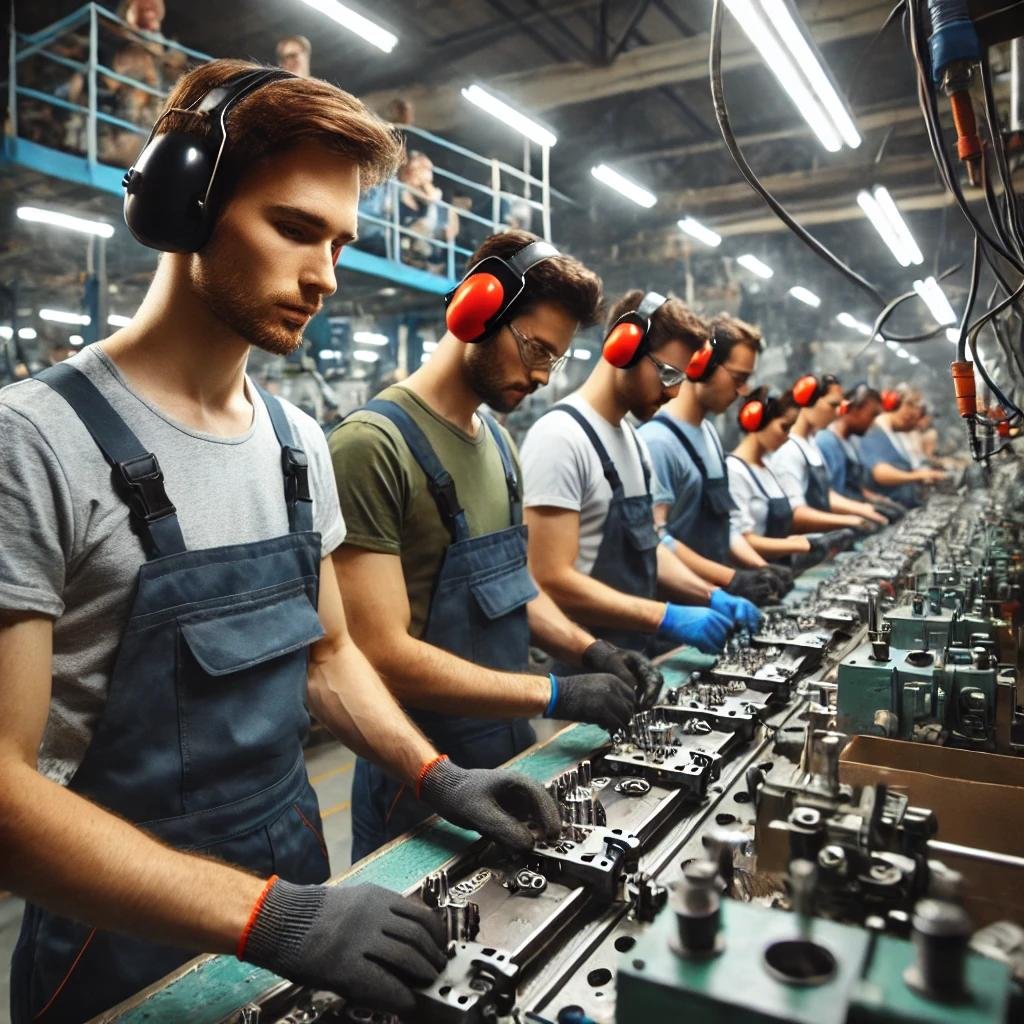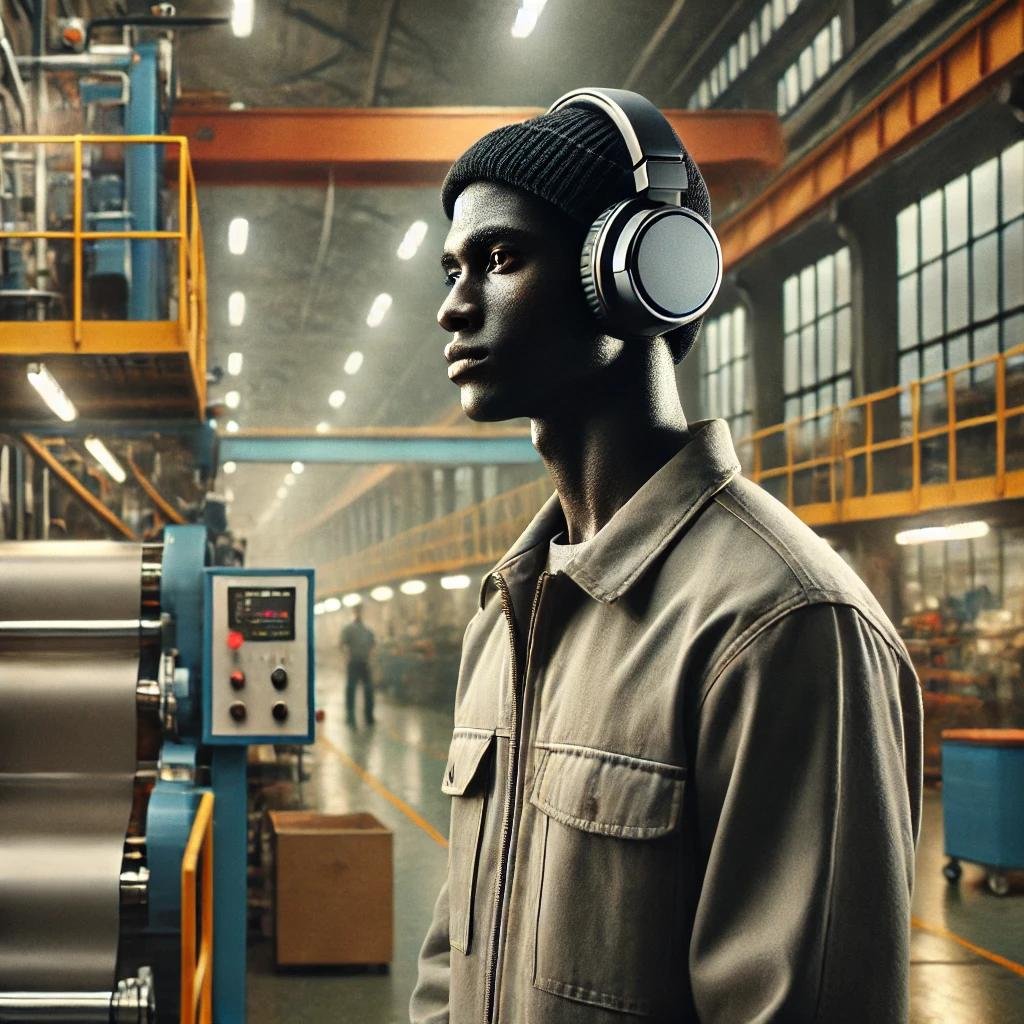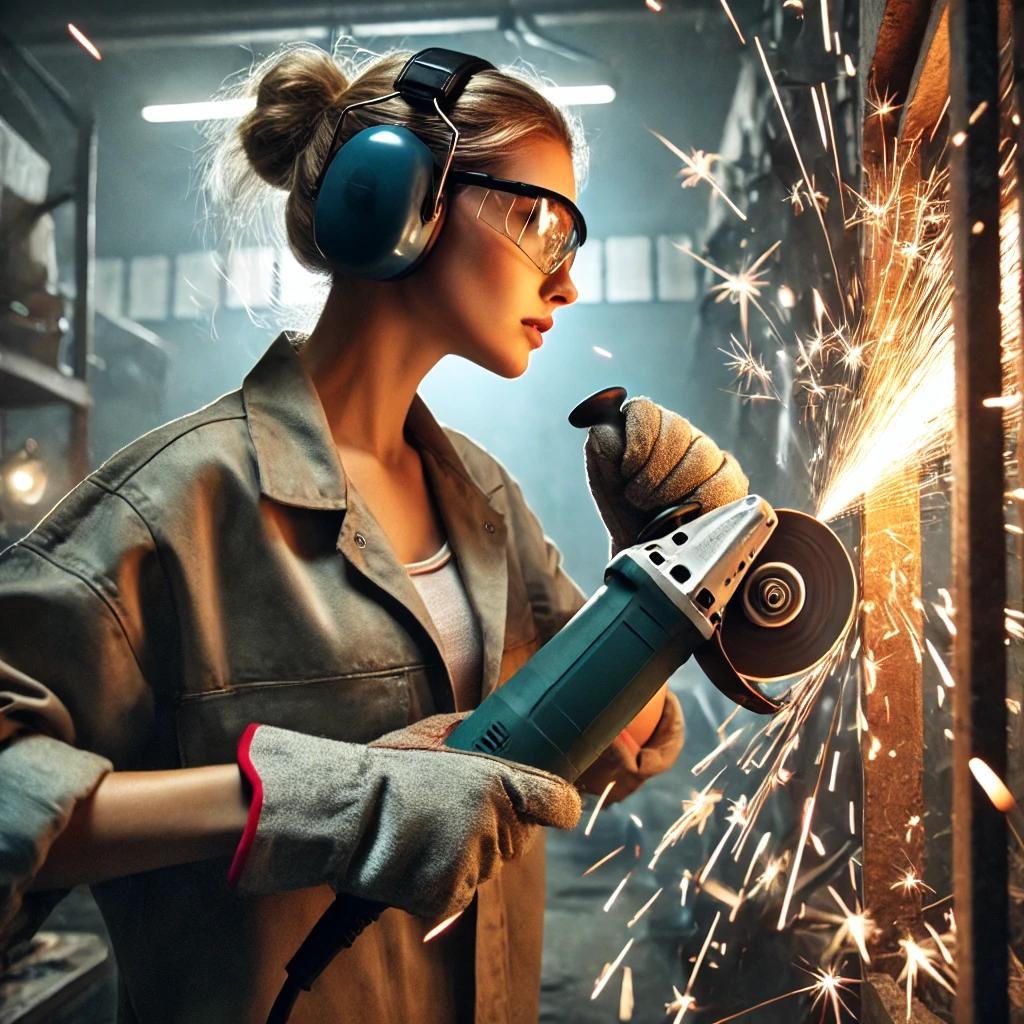
INFORMATION FOR EMPLOYERS ON CHOOSING AND USING THE RIGHT HEARING PROTECTION AT WORK
A need for hearing protection is probably the most common outcome of a noise assessment. Getting the right hearing protection is important, too little protection and employees remain at risk of hearing damage, while too much protection and people start to feel isolated, unable to hear things like forklifts or other vehicles, or simply unable to hear colleagues speak, so they don’t wear the protector properly to let more noise through, and are at risk of hearing damage again.
The noise assessment should make all the recommendations you need but if you want more information then this is your place.
SNR is your guide to how strong a hearing protector is
SNR - Single Number Rating, is a nice simple single figure which tells you how strong a hearing protector is. SNR ranges from ≈16 dB at the lowest to 39 dB at the highest.
Never use NRR, that is American and is only for people who think cheese can be squirted out of a can.
Never buy the strongest hearing protection you see
Hearing protection needs to be ‘enough but not too much’. Workplaces with average noise levels of around 90 dB(A) need hearing protection with an SNR of about 20 dB or so.
There is a point where stronger hearing protection gives lesser compliance and an increase in risk.
Cheap doesn’t always mean nasty, it just won’t last as long
Hearing protection varies in price but price isn’t a guide to how strong it is. For example, 3M’s Optime I muff has an SNR of 27 for about £14, while Beeswift’s BBED has an SNR of 28 for about £3.
More expensive will usually last longer and be more comfortable, but isn’t always ‘more safety’.
What are the employer’s obligations for hearing protection?
If your noise assessment confirms there is a noise risk then there are certain elements which apply and which the employer must comply with.
Noise assessment gives levels between 80 and 84 dB(A)
You have to make suitable hearing protection available, where ‘suitable’ means it is appropriate for the noise risk and not too strong.
You have to put signs up saying hearing protection is available.
You must tell people it is there and how to use it, but whether they use it can be left up to them.
Noise assessment gives levels of 85 dB(A) and over
This is where it gets a little more onerous.
You have to make suitable hearing protection available which again means calculating to make sure it is correct for the noise risk, and not too weak or too strong. Again, never buy hearing protection on the basis that ‘strongest is best’. Link: Problems with over-protection.
You must have signs up saying it is mandatory.
Hearing protection must be issued and usage is mandatory. It should not be shared between people.
Everyone must be trained in how to use it, how and when to replace it, and who to report problems to.
For reusable hearing protection, you must have somewhere clean for them to store it when not in use.
This is the bit most companies fall over on: You must have systems in place to monitor compliance with it and that it is used correctly, and take steps to enforce this. That includes disciplinary action for people who repeatedly do not wear hearing protection. You cannot issue it, tell them to wear it, and then that is the end of it. Without this monitoring and enforcement you can and will still be liable for issues.
E-A-R Soft FX ear plugs, among the strongest hearing protection on the market. Brilliant for trying to sleep in noisy hotels but pretty much no workplace needs this level.
There is nothing wrong with foam ear plugs as hearing protection though and they come in a huge range of strengths.
The lowest attenuating hearing protection on the market are plugs with an SNR of 14-16 dB, while the strongest on the market are also plugs with an SNR of 39 dB, and they cover all points between.
‘Low attenuating’ means it knocks a small bit of noise off.
How does SNR relate to average noise levels - which SNR is best for which level of noise?
It is natural for employers to reach for the strongest hearing protection on the market, but almost nobody needs the highest levels of protection available.
The most consistent issue I come across on noise assessments these days is hearing protection which is far too strong for the noise risk present.
Generally, once hearing protection passes an ideal point, the stronger it gets then the more risk it reintroduces from people not wearing the protectors properly to let more noise through again.
These are the average dB(A) levels a hearing protector’s SNR is suitable for.
That is average, meaning the overall result over a production cycle, not the highest dB(A) seen.
A common ear plug in use is the Laser Lite, the foam things that look like pear drops. They have an SNR of 35 dB but as you can see here, an SNR of 35 dB is suited to somewhere with an average noise level of 106 dB(A).
I have seen a lot of workplaces which can hit 106 dB(A) very briefly but cannot think of a single one which has a consistent noise around that level. Those Laser Lite plugs are far too strong for most noise risks.
The other common plug is the squishy yellow foam cylinder ones, the EAR Classic. They have an SNR of 29 dB which means they are suitable for somewhere with an average noise level of 100 dB(A), again that is far above most workplaces.
| SNR (dB) |
The noise level to achieve the ideal 75 dB(A) under the protector |
|---|---|
| 15 | 86 dB(A) |
| 16 | 87 dB(A) |
| 17 | 88 dB(A) |
| 18 | 89 dB(A) |
| 19 | 90 dB(A) |
| 20 | 91 dB(A) |
| 21 | 92 dB(A) |
| 22 | 93 dB(A) |
| 23 | 94 dB(A) |
| 24 | 95 dB(A) |
| 25 | 96 dB(A) |
| 26 | 97 dB(A) |
| 27 | 98 dB(A) |
| 28 | 99 dB(A) |
| 29 | 100 dB(A) |
| 30 | 101 dB(A) |
| 31 | 102 dB(A) |
| 32 | 103 dB(A) |
| 33 | 104 dB(A) |
| 34 | 105 dB(A) |
| 35 | 106 dB(A) |
| 36 | 107 dB(A) |
| 37 | 108 dB(A) |
| 38 | 109 dB(A) |
| 39 | 110 dB(A) |
More free information on hearing protection at work
How to know if a type of hearing protection is suitable for your noise risk
To do this you need two bits of information, the SNR for the hearing protection and the average dB(C) noise level for the workplace which should be in your noise assessment report.
Your simplest way is to put the figures into my free hearing protector assessment tool and it will tell you the answer, or you can do a simple calculation manually. Ideally you are then looking for a result of between 70 and 78 dB(A).
Read more on how to choose the right strength of hearing protection
Music headphones in high noise areas
A common issue found in noise assessments is the use of standard music playing headphones or ear buds in a high noise area. It doesn’t matter if they are noise-cancelling, this still cannot be permitted.
Standard headphones are not hearing protection, whatever the marketing claims of the manufacturer, and the employer is failing to meet its obligations to supply certified hearing protection and enforce its use. In addition, the headphone reduces external noise but then internally adds it all back in again and more.
Read more on use of music playing headphones in high noise areas
Can people be exempted from the use of hearing protection?
If it is a high noise area, i.e. over 85 dB(A), then the answer is that unless it is a very specific circumstance, no. They cannot sign disclaimers that they accept the risk of any hearing damage, these have no weight in law and are not allowed. GPs cannot give people an exemption from the use of hearing protection due to ear aches or headaches etc. There is one exception to that which is an employee who is so totally deaf that excess noise cannot damage their hearing further, but that is it.
The HSE can issue exemptions for very exceptional circumstances, but these are targeted at an organisation rather than as a blanket policy, are time-limited, and must be in writing.
Read more on disclaimers or GP exemptions from the use of hearing protection
Do forklift drivers have to use hearing protection?
If a forklift driver is entering a high noise area on the forklift and the noise assessment shows their noise exposure is 85 dB(A) or above, then there is no exemption for them from the need to wear hearing protection. It is a myth that forklift drivers are exempt from hearing protection, they are not.
Their hearing will still be damaged by excess noise, the fact they are on a forklift doesn’t stop that. What is important is that they have the right level of protection, that it is not excessive and does not isolate them from their surroundings.
Hearing protection questions
Sometimes questions come up as employers delve into hearing protection as the more you look at it the less clear-cut it can become.
We have some quiet areas and some noisy ones, can we allow people to use hearing protection in the quieter areas?
That’s absolutely fine, they can choose to wear them in quieter areas if they want, there are no blanket prohibitions on that. The only time it may become a problem is in places with things like forklifts whizzing around as you don’t want to stop people hearing those, or if it then meant they can’t hear sounds like fire alarms, but as long as that’s not the case then they can wear them if they wish.
We have hearing protection with a good low SNR but I have one person who really wants the strongest possible protection, are we allowed to do that?
The employer has to ensure the hearing protection they provide by default is suitable for the noise risk, which includes making sure it is not over-protecting (see below). But, if someone actively chooses to have stronger hearing protection than is needed then the issues of non-compliance which arise with over-protection are not going to be a problem, so as long as they can still hear any alarms or vehicles moving around them (if there are any) then it is OK.
We have been told our hearing protection is too strong, surely there is no such thing as too much protection?
As a very rough summary, hearing protection is something of a bell-curve. If it is too weak then there is a lot of risk, if it is spot-on then the risk is controlled, but then when it gets to be too strong people stop wearing it properly to allow more sound through, and the risk increases again. As hearing protection gets too strong then generally risk goes up, not down. I have more detail on this here: risks of over-protection.
I have an employee with a letter from his G.P. saying he is exempt from using hearing protection as it irritates his ears, is this allowed?
No, a G.P. cannot exempt someone from a need to wear hearing protection in a high-noise area, they do not have the power to over-rule the law. If there is a noise risk then hearing protection is needed. At the risk of making that slightly less clear, there are actually two exceptions to this: If a specialist writes confirming that someone has a form of profound hearing loss which cannot be made worse by excess noise then hearing protection need not be worn, but that is usually someone who is pretty much totally deaf already and their ears are doing nothing more than keeping glasses straight. Also, the HSE can grant time-limited exceptions in very limited circumstances if the hearing protection use introduces a larger risk. Read more: Disclaimers or GP letters exempting hearing protection.
I have someone who wants to use noise-cancelling headphones instead of hearing protection, is that OK?
A very common situation and question these days but one with an easy answer - no, they cannot be used. Standard noise-cancelling headphones are not certified as hearing protection so cannot be used. If you have hearing protection with Bluetooth music playback then that is fine, but they are hearing protection first and foremost. You can read more on this here: noise-cancelling headphones as hearing protection.

More articles and information on use of hearing protection at work
Link: Hearing protection assessment tool
Link: Over-protection, what are the issues?
Link: Hearing aids and hearing protection in high noise areas at work
Link: What to do if someone refuses to wear hearing protection
Link: Wearing double hearing protection - mostly utter nonsense











